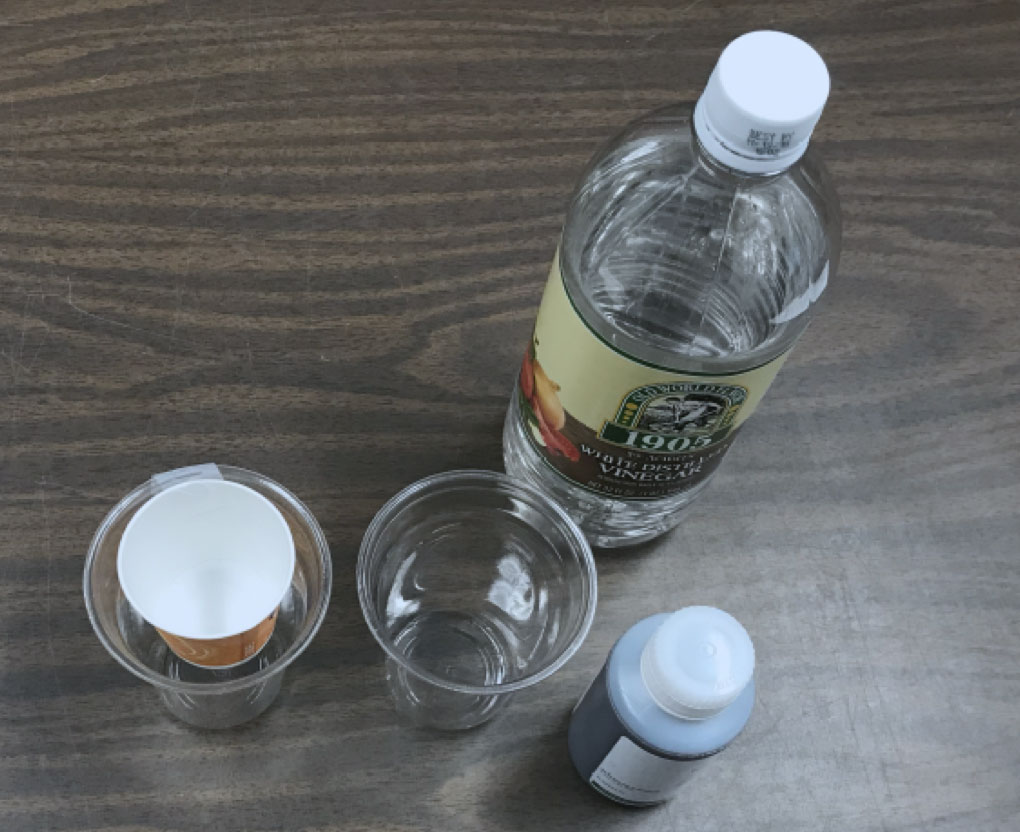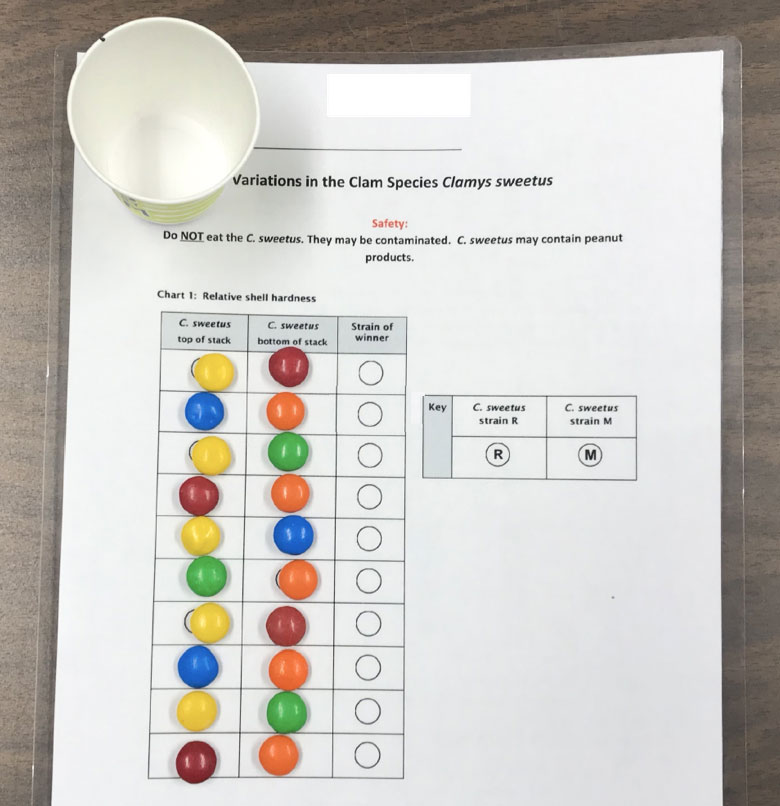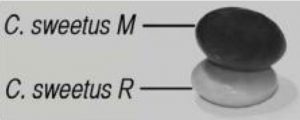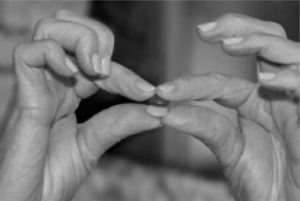Activity 4: Variations in the Clam Species Clamys sweetus
Learning Targets
- Youth will understand that all organisms have a different DNA sequence.
- Youth will be introduced to gene mutations and their potential effects.
- Youth will become familiar with ocean acidification and the effect it may have on specific organisms.
Time to complete activity: 45 – 60 minutes
Background for facilitator
Note: All links are provided purely for educational purposes. No responsibility is assumed for any content on the linked site(s).
Note: Part one of this activity includes a material that contains peanuts. Please be aware of any allergies before proceeding with this activity.
The study of DNA sequencing continues in this activity (from Activity 3, Aquaculture and DNA). Changes in the DNA sequence, caused by gene mutations, can be caused intentionally through breeding strategies or unintentionally, acquired over an individual lifetime, and then passed onto future generations. This activity begins with a deeper dive into DNA by applying it to a specific species, in this instance, dogs. Three DNA sequence strands are constructed. All three are types of dogs, but are different breeds or have unique traits. Participants will begin to see how small changes in a DNA sequence, particularly those that may have occurred can influence breed traits. Over a period of time, these small changes, or mutations, can impact species survival because of natural selection. Through natural selection, generally the strongest or hardiest survive.
Changes in the chemical structure of ocean waters are changing. Youth will explore the visual changes that can occur when the pH of water changes, by seeing what happens when a base is added, and similarly, when an acid is added to water. Ocean acidification, or the increase of acid levels in the ocean waters is happening in Maine coastal waters. These changes are a result of increased carbon dioxide levels in the atmosphere, which are being absorbed into ocean waters, therefore increasing acidity levels of those waters.
Participants will simulate the impact of ocean acidification on shellfish. Increasing acid in the waters they live in is something that scientists are currently studying. They are discovering that exposure to these chemical changes are impacting the hardness of the shells of shellfish, such as mussels, oysters and clams.
Small changes in any living things environment, particularly those changes that are long term, can cause adaptations in those environments. Specifically, individual organisms may adapt, in order to survive in that environment. Scientific research is demonstrating that these changes can result in genetic mutations of some marine organisms (ex. Shrimp, corals, sea urchins). It is unknown at this time if Gulf of Maine clams exposure to ocean acidification is resulting in changes in DNA proteins, or gene mutations.
Vocabulary List
- Natural Selection: the process whereby organisms better adapted to their environment tend to survive and produce more offspring. The theory of its action was first fully expounded by Charles Darwin and is now believed to be the main process that brings about evolution.
Key concepts to address throughout this activity
- How does natural selection preserve favorable traits?
- What evidence is there that variation exists within a population?
- What role does variation play in the evolution of a species?
Materials
- Crayons and colored pencils
- Dog traits key
- Paper
- Tape
- Envelopes
- DNA strips
- Safety glasses
- 3 oz paper cups
- 10 oz plastic cups and lids
- Masking tape
- Permanent markers
- White paper
- Acid-base indicator solution
- Baking soda
- White vinegar
- Graduated cylinders
- Measuring spoons
- Ziploc bags marked “C. sweetus strain M” (10 chocolate candies with a hard candy shell)
- Ziploc bags marked “C. sweetus strain R” (10 peanut butter candies with a hard candy shell)
- 1 paper cup
- Youth handouts
- Dry erase markers
Methods
Before you begin or hand out any materials, be sure that no one in your group has a peanut/nut allergy.
Activity: “A Recipe for Traits”:
In order to reinforce the concepts learned in the “Aquaculture and DNA” activity, youth will create a dog image based on DNA-linked traits. The activity instructions are available online: A Recipe for Traits (PDF).
Video 1
Engage

- Briefly introduce ocean acidification to the youth.
- Ocean acidification occurs when carbon dioxide is absorbed by the ocean, increasing the acidity of the water.
- Tell youth that they will perform an experiment to demonstrate ocean acidification.
- Give each youth two clear plastic cups and a paper cup.
- Remind youth to always put on safety glasses when they do a science experiment.
- Walk the group through the following instructions:
- Pour 50 mL of acid-base indicator solution into each of the two clear plastic cups.
- Add 2 g of baking soda to the paper cup.
- Tape the paper cup inside one of the clear plastic cups so that the top of the paper cup is about 1 cm below the top of the plastic cup. The bottom of the paper cup shouldn’t touch the liquid in the plastic cup — you don’t want it to get wet! The plastic cup without the paper cup in it is the control model in this experiment.
- Place the plastic cups onto a sheet of white paper and hold up another sheet of white paper behind the cups (this is for observation purposes).
- Add about 5 mL of vinegar to the paper cup. Be careful not to spill any vinegar into the indicator solution.
- Observe the changes in the paper cup model. After a few minutes, you should notice a color change at the surface of the liquid. As time passes, the rest of the liquid will also change color.
Video 2
Explore
- Group youth into pairs.
- Have each youth make a list of words or phrases that come to mind when they hear the term “natural selection.” Allow a few minutes for this but no more than three or four.
- After the lists have been compiled, the group should discuss the words they chose and their reasons for including them. Each group should select two words from their lists for sharing with other groups.
- Write these words on a poster or whiteboard if available having a brief discussion of what natural selection is.
Explain

- Tell the group that today they will be making observations about two clam species in the Gulf of Maine and comparing them to each other. Since global climate change is leading to ocean acidification you want to figure out which variant of the species would survive and work best as an aquaculture species. (Note that the Gulf of Maine is feeling the effects of ocean acidification stronger and more quickly than any other body of water on the planet).
- Within the pairs, have youth figure out traits that are different between Strains M and R without removing them from their bags.
- Come together as a group and list out the similarities and differences between the two.
- Explain to the group that you want to compare the strength of each strain’s shell since ocean acidification impairs thinner or weaker shells more quickly than the stronger or thicker shells.
- To make this comparison, tests must be performed on the clams.
- Explain that to compare the strength of the shells, they will be crushed together to see which breaks first.
- As an example take one of each strain and demonstrate the crushing procedure shown in Figures 1 and 2.
- Figure 1: Stack of clams
- Figure 2: Crushing technique
Video 3
Elaborate
- Hand out one bag each of Strain M and R to each group.
- Provide each participant with a youth handout.
- Read the following as the youth complete each step, demonstrating proper crushing technique (Fig. 2) as you go along.
- Select one C. sweetus M and one C. sweetus R from your containers and place them as a pair on the appropriate circles on Chart 1: Relative shell hardness on your handout. Before starting the experiment, all 10 pairs should be in place on the handout.
- To determine which clam has the stronger shell, pick up the first pair of C. sweetus strain M and strain R clams. Stack one on top of the other as indicated by your handout. (Fig. 1)
- Hold the two clams so that your thumbs are on the bottom surface and your index fingers are placed securely on the top.
- Evenly apply pressure to the top and bottom of the stack. As soon as one of the shells cracks, stop. Examine the two specimens and determine which one cracked first. If it is impossible to determine which clam cracked first, record the one whose shell cracked the least.
- Indicate the survivor by recording the appropriate letter in the circle in the Strain of winner column. Place both clams in the waste container.
- Repeat the above procedures (1-2 through 1-5) a total of 10 times.
- In Chart 2, record the number of each variation present in the population before and after crushing.
- Have the groups give you their numbers/share with the entire group.
- Have each pair figure out what percentage of the population each strain is using the whole group’s data and complete the graph below chart 2.
Evaluate
Ask participants to first discuss these questions in their pairs. Then, come together as a whole group to reflect on these questions collectively:
- When analyzing the results, why is it important to use the whole group’s data and not just the data obtained by an individual team?
- Is there a difference in shell strength between the two varieties? Support your claim with evidence.
- If it could tell the difference, which variety might an arthropod (crab) seek out as it hunts for food? Why?
- Describe how acidification might affect the numbers of the two varieties in this and future populations of sweetus, taking all of the data we collected into account. Support your claim with evidence.
- What connections do you see between the DNA activities and the impact of ocean acidification on clam species? What else might scientists want to know?
- Which species would you choose to farm (aquaculture) in the Gulf of Maine? Why?
Additional Resources
- A climate calamity in the Gulf of Maine videos:
- More on ocean acidification and increasing CO2 levels
- Research from Maine on lobsters and ocean acidification (YouTube)
Clamys sweetus activity adapted with permission from the Howard Hughes Medical Institute

 This activity is supported by National Science Foundation award #EPS-0904155 to Maine EPSCoR at the University of Maine.
This activity is supported by National Science Foundation award #EPS-0904155 to Maine EPSCoR at the University of Maine.


